
59 minute read
3.6 Porsche Torque Vectoring Plus (PTV Plus
Power transmission 3
Like the current 911 Carrera models with Porsche Doppelkupplung (PDK), the new 911 GT3 also features the driving dynamics-oriented drive-off function “Launch Control” for maximum acceleration from standstill. Compared with these models, this function on the new 911 GT3 can be activated at any time without pressing any other buttons or switches. Readiness for an accelerated start is indicated in the tachometer on the instrument cluster as on the 911 Carrera models.
The new 911 GT3 features Porsche Torque Vectoring Plus as standard. The system includes an electronically regulated, fully variable rear differential lock with selective braking interventions on the rear left or rear right wheel. The function of the overall system is described in section “4.10 Control systems”.
4.1 General
The chassis of the new 911 GT3 is based on the current 911 generation, but its components have been modified significantly compared with the 911 Carrera models and the previous model.

04_01_14
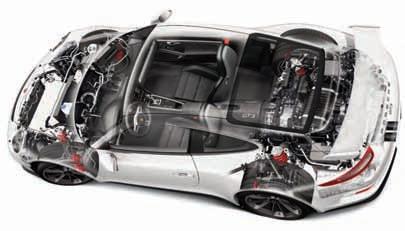
The 911 GT3 has the following new product features and modifications:
• Dynamic engine mounts as standard equipment • New wheel carriers on the front and rear axle for more precise wheel guidance • Optimization of wheel guidance on the front axle using new spring struts and ball joints on the supporting mount and outer wishbone • Optimization of wheel guidance on the rear axle using a new wheel carrier, optimized steering geometry and ball joints on the outer wishbone and lower spring strut connection • Larger wheel bearings and wheel hubs on the front and rear axles for more precise wheel guidance also with higher loads through larger 20-inch wheels • Rear axle with helper spring • New 20-inch GT3 wheels with central lock, weight- and rigidity-optimized • Tire Pressure Monitoring System (TPM) with racetrack mode Chassis 4
The specifications in the PIWIS information system and the instructions in section 0 of this SIT must be observed when working on the chassis.
4.1 General 47 4.2 Wheelbase and track widths 49 4.3 Front axle 50 4.4 Steering 51 4.5 Rear axle 52 4.6 Rear-axle steering 53 4.7 Brake system 56 4.8 Wheels and tires 59 4.9 Front axle lift system 62 4.10 Control systems 63
Chassis 4

These modifications have improved overall driving dynamics, including wheel guidance, reinforced brake system and traction provided by the large 20-inch GT3 wheels.
Like the previous model, the chassis of the new 911 GT3 also has the following characteristics and distinguishing features compared with the 911 Carrera:
• Lowering by approximately 30 mm accompanied by a corresponding lowering of the vehicle’s center of gravity • Specific spring, damper and anti-roll bar tuning • Adjustable anti-roll bars at front and rear (three settings) for adaptation to individually desired handling characteristics • Split wishbones on the front and rear axles for improved and individual camber adjustment1 • Control arms on the front and rear axles partially with ball joints for more precise wheel guidance • Wheels with central lock • Sport tires2 • Vehicle stability system Porsche Stability Management (PSM) with special tuning and 2-stage switching function for complete deactivation (ESC OFF and ESC+TC
OFF) • Front axle lift system (optional)
1) These modifications are only permissible for vehicle operation off public roads, as they have a very pronounced effect on the vehicle’s handling characteristics.
When changing vehicle settings and/or modifying components, reciprocal interactions must be taken into consideration. 2) There is increased danger of hydroplaning on wet roads due to the low tread depth.
For improved driving dynamics through increased driving and steering stability, the new 911 GT3 has a much longer wheelbase and a greater track width on both the front and rear axles compared with the previous model.
1 - Track width increased by 54 mm at front 2 - Wheel base increased by 102 mm 3 - Track width increased by 31 mm at rear
These changes increase the support area of the new 911 GT3, thereby improving longitudinal and lateral stability. The support area (wheel base x track width), which is 7.3% larger than on the previous model, allows a further increase in vehicle stabilization, resulting in high driving and steering stability, particularly in extreme driving situations, such as driving on race circuits. The large track width on the front axle supports steering stability during highly dynamic cornering.

Wheelbase and track widths 04_02_14 Chassis 4

Chassis 4

The McPherson front axle was largely newly developed. Unique-design wheel carriers as well as larger wheel bearings and wheel hubs increase stability and load capacity. This was necessary due to the higher load on the chassis elements as a result of the larger wheels and enhanced driving dynamics. These measures have increased the camber rate by approximately 10% compared with the previous model.
The sturdy connection of the spring strut to the wheel carrier was also improved. The twin-clamp system introduced for the previous model now has a clamping distance of 170 mm (997 GT3 II: 50 mm). This connects the spring strut even more securely to the wheel carrier and improves rigidity for more precise wheel guidance. The wishbone on the front axle was also completely redesigned in terms of its stability and weight. Like the previous model, the new 911 GT3 also has a split lower wishbone, which allows individual camber adjustment by way of various shims for driving on race circuits. The outer connection of this wishbone on the wheel carrier by way of a ball joint is new. Compared to a conventional connection by means of elastokinematic link pins, the ball joint connection reduces elasticity, resulting in even more precise handling.
To reduce weight, the new 911 GT3 has lighter chassis springs, which offer a weight saving of 3.5 lbs. (1.6 kg) per vehicle compared to the previous model. The weight of the spring struts was also reduced by 3.5 lbs. (1.6 kg) per vehicle by replacing the steel outer tube with an aluminum tube.
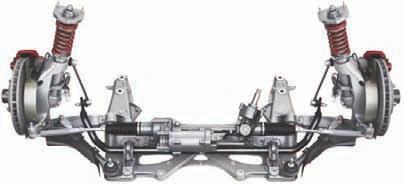
04_03_14
The new 911 GT3 now features electromechanical power assistance with speedsensitive steering torque control. The main functions of the system were adopted from the current 911 Carrera generation (991). The tuning of the steering functions has been adapted specifically to suit the 911 GT3 and ensures even more immediate steering behavior with unique steering torques.

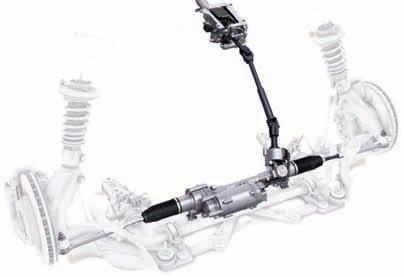
Electromechanical steering
04_04_14
The new steering system ensures immediate and agile as well as precise steering with informative feedback. Electromechanical power assistance also helps to reduce fuel consumption compared with the hydraulic power assistance system used on the previous model. Chassis 4
Chassis 4

The multi-link rear axle was largely newly developed. Unique-design wheel carriers and wheel hubs as well as larger wheel bearings also increase stability and load capacity here. To further ensure the high load capacity, the subframe, including side sections and cross member, was newly developed. In addition to geometric modifications, the weight of the cross member was also reduced by 8.6 lbs. (3.9 kg) by using hollow-cast aluminum instead of welded steel. With this change, the subframe has basically the same design as that used on the new 911 GT3 Cup racing car.
An additional reinforcement plate between the left and right diagonal strut is also new. This “shear panel” increases the camber rate of the rear-axle subframe by approximately 10% compared with the previous model and ensures even more precise wheel guidance.
The lower longitudinal and transverse control arms have also been completely redesigned in terms of their stability and weight. Like the previous model, the new 911 GT3 also has a split lower wishbone on the rear axle for individual camber adjustment for driving on race circuits. In addition, the lower wishbone has a ball joint at the outer joint connections to further optimize wheel guidance. In order to realize the rear-axle steering, the rigid tie rods were replaced with variable control arms with electromechanically adjustable actuators.
The use of a spring/shock absorber element on the rear axle with an additional spring (helper spring) is also new for the 911 GT3 (991). Like the 911 GT3 RS 4.0 (997 II), the new 911 GT3 also features a weight-reduced suspension system with a lighter main spring and an additional spring.

04_05_14
General
The new 911 GT3 features rear-axle steering as standard. The system comprises two electromechanical actuators, which are used instead of the conventional toe control arms at the left and right of the rear axle. The system steers the rear axle, depending on the speed, within a range of approximately +/- 1.5 degrees in the opposite direction to or in the same direction as the steering angle on the front axle. The steering angle on the rear axle thus depends above all on the steering angle on the front axle, the driving situation and the driving speed.
At speeds of up to approximately 30 mph (50 km/h), the system steers the rear wheels in the opposite direction (counter) to the front wheels. In terms of geometry, this results in a virtual shortening of the wheelbase by approximately 5.9 in. (150 mm) and ensures both greater agility and day-to-day usability. This facilitates maneuvering and parking and keeps the turning circle small despite the large track width on the front axle.
At speeds of over approximately 50 mph (80 km/h), the system steers the rear wheels parallel to the front wheels (same direction). In terms of geometry, this results in virtual lengthening of the wheelbase by approximately 18.7 in. (500 mm) and increases driving stability, particularly at high speeds. At speeds of between 30 and 50 mph (50 and 80 km/h), the system continually switches between steering in the same and opposite direction, depending on the driving situation.

Rear-axle steering 04_06_14 Chassis 4

Chassis 4


Electromechanical actuator 04_07_14 Thanks to its variability, rear-axle steering helps to resolve the conflict of objectives in terms of driving dynamics between agility and driving stability. The result not only offers advantages in terms of maneuverability, driving safety and day-to-day usability, but also increases driving dynamic performance. Rear-axle steering also improves lap times on the Nürburgring Nordschleife and offers advantages during other comparison tests reported in the automotive press. A significantly higher average speed can be achieved during the obstacle avoidance test (360 ft./110 m) and slalom test (118 ft./36 m) with rear-axle steering.
Greater agility (counter steering)
• Better steering behavior and handling • Enhanced driving dynamics and performance • Greater driving pleasure
Increased driving stability (parallel steering)
• Enhanced driving dynamics and performance • Further improved straight-ahead tracking at high cruising speeds • Improved driving safety
Improved day-to-day usability (counter steering)
• Easier to maneuver and park • Small turning circle
System description
The system comprises two electromechanical actuators, which are installed instead of the conventional toe control arms on the rear axle and are synchronized electronically. The actuators consist of an electric motor, which drives a threaded spindle by means of a belt drive, thereby converting the rotational movement into linear movement. Rear-axle steering adjustment allows a maximum rear-axle steering angle of approximately +/- 1.5 degrees.
By way of comparison, a steering angle of 1.5 degrees on the wheels of the front axle is comparable with a steering angle of approximately 20 degrees from the center position on the steering wheel.
The two rear wheels are adjusted synchronously, both in the opposite direction to and in the same direction as the front wheels. Adjustment control essentially depends on the vehicle speed and the steering angle on the front axle.

Function overview 04_08_14
1 - Agility (up to approximately 30 mph (50 km/h)
Counter steering (maximum + 1.5 degrees)
Virtual shortening of the wheelbase (approximately 5.9 in./150 mm)

2 - Stability (from approximately 50 mph (80 km/h)
Parallel steering (maximum - 1.5 degrees)
Virtual lengthening of the wheelbase by (approximately 18.7 in./500 mm)
Driving dynamics
At speeds of up to approximately 30 mph (50 km/h), the rear wheels are turned in the opposite direction to the front wheels. This enables the vehicle to turn faster into the bend and allows more dynamic steering behavior. Together with the virtual shortening of the wheelbase, this improves both agility and driving pleasure as well as day-to-day usability (easier to maneuver and park, small turning circle). At speeds of over approximately 50 mph (80 km/h), the rear wheels are turned in the same direction as the front wheels. As a result, lateral forces, in particular, are built up faster than with an unsteered rear axle. In contrast to counter steering at speeds of up to approximately 30 mph (50 km/h), the additional cornering forces on the rear axle are directed in the same direction as the front axle here. This results in faster as well as more spontaneous and more harmonious initiation of changes in direction. Chassis 4

1 - without rear-axle steering 2 - with rear-axle steering
Chassis 4


Standard brake system 04_10_14
Technical data

Standard brake system
The new 911 GT3 has an enhanced standard brake system with brake discs made of gray cast iron on the front and rear axle. The main features are larger brake discs on the rear axle, modified ventilation holes on the brake discs and improved brake ventilation with additional brake air ducts on the rear axle. These features increase both braking performance and the stability of the brake system. The brake booster was also redesigned. Based on the current 911 generation (991) with a tandem brake booster made of aluminum, the new 911 GT3 has a boost ratio of 3.5:1, just like the previous model. Compared with the boost ratio of 5.5:1 on the current 911
Carrera models, the new 911 GT3 offers a more immediate brake pedal feel and improved brake system control. To reduce weight and unsprung masses, the new 911 GT3 is equipped with composite brake discs derived from motor racing with brake discs (“friction rings”) made of gray cast iron and aluminum brake disc hubs. For improved corrosion resistance and a better look, the aluminum brake disc hubs on the front and rear axle are painted gray. The brake disc hubs and brake discs are connected with stainless-steel pins arranged radially.

The ventilation holes on the brake discs were enlarged from a diameter of 4 mm to 5 mm on the front and rear axle and the edges of the holes are now rounded. In addition to better ventilation and reduced brake disc weight as a result of the larger holes, rounding of the edges of the holes, which was adopted from motor racing, also reduces the notch effect, thereby increasing component strength even under very high loads. The front axle of the new 911 GT3 is fitted with a unique-design, high-performance brake system with 6-piston aluminum monobloc fixed calipers and brake discs with a diameter of 380 mm. The rear axle of the new 911 GT3 has a unique-design, high-performance brake system with 4-piston aluminum monobloc fixed calipers. The brake discs were enlarged from a diameter of 350 mm (997 GT3 II) to 380 mm.
Brake cooling
For the new 911 GT3, brake cooling on the front axle and rear axles have been modified significantly. This results in lower brake temperatures, leading to reduced wear and even greater braking performance under high loads. On the front axle, the brakes are cooled in the usual way by way of brake air spoilers and air deflecting blades. A new feature here is the significantly improved air supply system via the brake air spoilers, particularly through a wider and larger air flow duct via the underbody panelling.
There is a further significant improvement in brake cooling on the rear axle. With one additional brake air duct on each side, the new 911 GT3 now has a total of four independent, closed brake air ducts instead of two as on the previous model. Air is still supplied to the front brake air ducts (1) via the underbody panelling and is routed in a targeted manner to the brake discs in the area of the brake calipers. The new, additional brake air ducts (2) are offset slightly behind these and are supplied with air freely via the underbody. Using these ducts, air is routed to just before the brake discs so as to provide additional cooling for the brake system in the lower area. Chassis 4
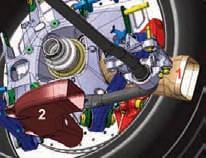
Brake air routing on rear axle 04_11_14
Chassis 4


PCCB brakes 04_12_14 The GT3 can optionally be equipped with an enhanced ceramic brake system Porsche Ceramic Composite Brake (PCCB). The new PCCB system offers a further improvement in braking performance and wear resistance compared with the previous model. Braking performance is increased above all by using larger brake discs and friction surfaces and improved brake cooling. Increased wear resistance, even under particularly high loads, is achieved above all thanks to an enhancement of the ceramic composite material. The brake discs were enlarged from a diameter of 380 mm to 410 mm on the front axle and from 350 mm to 390 mm on the rear axle. This measure increases the effective friction surface by approximately 14% on the front axle and by approximately 20% on the rear axle. The cross-drilled PCCB brake discs are mainly cooled by redesigned cooling ducts in the brake discs and the efficient ventilation of the brake system.
The PCCB brake disc hubs on the front and rear axle of the new 911 GT3 are made of forged aluminum and are anodized black. In addition to the lightweight brake discs made of a ceramic composite material with a weight saving of approximately 50% compared with conventional brake discs made of gray cast iron, the lightweight brake disc hubs help to reduce the vehicle weight and in particular the unsprung masses.
The weight saving compared to stainless steel brake disc hubs is also approximately 50%. The brake disc hubs and brake discs on the front and rear axle are connected by way of threaded sleeves and tensioning springs. The material composition of the ceramic brake discs, particularly the outer friction layer, has been completely modified. Here, a significant improvement in the wear resistance of the new generation of discs was achieved by significantly increasing the ceramic content in the ceramic composite material using carbon fibers.
Parking brake
Similar to the current 911 Carrera models (991), the 911 GT3 (991) features an electrically operated parking brake. The operating button is at the left of the steering wheel on the lower part of the dashboard. The parking brake can be activated manually using this button and deactivated while pressing the footbrake. It is also released automatically when the driver’s intention to drive off is detected via the accelerator pedal. The electrically operated parking brake increases comfort and safety when the vehicle is parked and creates more space in the center console due to omission of the handbrake lever.
General


The new 911 GT3 has completely redesigned wheels on the front and rear axle. Compared with the 19-inch wheels on the previous model, the new 20-inch GT3 wheels are not only one inch larger, but are also half an inch wider on the front axle. The tires on the front axle are also wider.
In combination with the sports tires with larger wheel contact surfaces and the chassis set up specifically for the vehicle, the new GT3 wheels offer the following advantages:
• Very high lateral acceleration at high cornering speeds • Precise handling and steering • Optimum acceleration and braking performance
The larger wheels and tires improve both traction and performance potential. In addition, the wider wheels and tires on the front axle offer a higher lateral force potential with additional dynamics when steering into a bend. The wheels are made of forged aluminum. Compared with the cast aluminum wheels on the previous model, the forged design ensures a lower weight and a high load capacity. Together with the weight-reduced wheel design, it was therefore possible to maintain the same wheel weight as the previous model on the front axle despite increasing the size of the wheels by one inch to 20 inches and increasing the width by half an inch to 9 inches. On the rear axle, the wheel weight was reduced by 6.2 lbs. (2.8 kg) per vehicle despite the increase in the wheel size by one inch to 20 inches. This reduces not only the vehicle weight, but also the unsprung masses in order to improve driving dynamics. Tire sizes and tire makes can be found in the current specifications in the PIWIS information system.
Chassis 4
Chassis 4


Central wheel lock 04_13_14 The wheel design is an attractive design that has evolved from the familiar 19-inch GT3 wheel. The design with five V-shaped double spokes was significantly enhanced and the individual spokes are now more striking. In addition, the rim flange area of the rim base is much flatter.
With these design features, the new 20-inch GT3 wheel - apart from the geometric increase in size by one inch - looks much bigger and its dynamic overall design emphasizes the enhanced driving dynamics of the new 911 GT3. The platinum colored paint finish on the wheels also emphasizes their high quality and adds to the puristic appearance of the new 911 GT3. Similar to the previous model, the standard sports tires on the new 911 GT3 also offer exceptional performance potential for high traction, lateral acceleration and short braking distances, particularly on dry roads. There is, however, increased danger of hydroplaning on wet roads due to reduced tread depth compared with conventional tires.
Central wheel lock
The central wheel lock is a completely new development that offers higher load limits and greater suitability for driving on race circuits. The central wheel lock specific to the new 911 GT3 is characterized by a more robust wheel hub for a significantly increased camber rate and by driving pins that are now fixed to the wheel hub (997 GT3 II: attached to the brake disc hub). The significantly improved connection system also includes larger bearing pins and larger wheel bearings, which are now identical to those used on the 911 GT3 Cup racing vehicles. The central bolts have a friction-optimized trapezoidal thread and a thread run-out with a reduced notch effect.
The new central bolts are visually distinguished by the modified toothed rim. The dimensions and basic shape of the central bolts have been retained and the teeth have been accentuated by distinct spaces. The central bolts on the new 911 GT3 are anodized black and have a black wheel hub cover with a silver-colored “GT3” logo.
Similar to the previous model, the new 911 GT3 also features Tire Pressure Monitoring (TPM) for permanent monitoring of all four wheels as standard equipment. The basic functions of the system are largely unchanged. The additional function “Racetrack mode” is new. Like the Carrera GT, the new 911 GT3 has an additional function which allows precise monitoring of an individually set tire pressure while driving on a race circuit.
The air temperature in the tire and the tire pressure - increases during intensive driving on a race circuit. An increase in the air temperature in the tire of 122° F. (50° C.) and therefore an increase in tire pressure of approximately 7 psi (0.5 bar) is not unusual. When the tire pressure increases, the tire’s tread becomes deformed and contact with the road is reduced. To achieve the best possible road contact surface and therfore the best traction again, the tire pressure must be reduced. However, if the tire pressure is reduced by more than 6 psi (0.4 bar) when Racetrack mode is switched off, the red warning message “Tire pressure” will appear on the screen in the instrument cluster. The tire pressure warning light in the instrument cluster stays on even after this message is acknowledged and prevents any further system monitoring of the tire pressures that were set individually for driving on the race circuit.
To ensure that precise tire pressure monitoring is also still possible when driving on race circuits, Racetrack mode allows individual adaptation of the required tire pressure, which is predefined in on-road mode. This function is set using the “Tire pressure” menu on the instrument cluster. When Racetrack mode is activated, a stylized race circuit with a yellow “R” is displayed permanently on the screen in the instrument cluster. When you have finished driving on the race circuit, the tire pressure must be changed back to the tire pressure required for driving on public roads in order to guarantee safe driving on public roads. A detailed description of how to activate and deactivate the TPM Racetrack mode can be found in the Owner’s Manual. Chassis 4

Chassis 4

A pneumatic lift system on the front axle is optionally available for the new 911 GT3. With new individual components, it is also possible to significantly increase the dayto-day usability of the new 911 GT3 by lifting the body at the front by approximately 30 mm at speeds of up to 30 mph (50 km/h). This prevents damage to the body and significantly reduces the risk of impact, e.g. when negotiating steep approaches and speed bumps. The lift system is also extremely useful when loading vehicles onto race car transporters.
The function, which uses an electropneumatic function module in the PASM dampers on the front axle, has largely been adopted from the previous model. Its operation via a special control button in the center console is also essentially the same. The structural design of the function module is completely new. This has been adapted to suit the available space on the new 911 GT3 and includes new function elements. A new valve block has also been used to refine and increase the sensitivity of the function and position detection features of the system control.
The function module is still a compact unit located at the front of the center tunnel and is approximately 31.5 inches (80 cm) long. The pneumatic compressor generates a pressure of up to 290 psi (20 bar) if necessary. The pressure reservoir has a filling volume of approximately 1.06 quart (1 liter) and stores the pressure required for operating the system. The compressed air system is controlled by means of a valve block unit. The system weight of all components of the front axle lift system is approximately 15.4 lbs. (7 kg).

Front axle lift system 04_14_14
Porsche Stability Management (PSM)
The new 911 GT3 also has a vehicle stability system with special sports tuning. Porsche Stability Management (PSM) can also be deactivated completely in two stages on the new 911 GT3 using the ESC OFF and ESC+TC OFF functions. With this deactivation strategy, which is differentiated using two buttons, PSM also provides extremely sporty drivers with sufficient variation options to satisfy individual requirements with regard to driving dynamics on the new 911 GT3. A new feature here is the specific tuning of the new 911 GT3 with even more precise and more sensitive control and adjustment.
The PSM basic setup offers high active safety. Traction Control (TC) for longitudinal dynamics, with the sub-functions automatic brake differential (ABD), anti-slip regulation (ASR) and engine drag torque control (MSR) as well as Anti-lock Braking System (ABS). Electronic Stability Control (ESC) for lateral dynamics, particularly through wheel-specific braking intervention when over- or understeering.
In the 1st switch-off stage ESC OFF, the system offers increased driving dynamics on race circuits by deactivating lateral dynamics control (Electronic Stability Control). This enables the vehicle to be steered around corners with the required drift using targeted steering movements and/or accelerator pedal control. The sportily tuned longitudinal dynamics control (Traction Control) with high traction through ABD and active safety through ASR and MSR remain active in this driving mode.
In the 2nd switch-off stage ESC+TC OFF, the driving dynamics control systems are deactivated completely. This allows personalized racing-oriented handling on the race circuit. Chassis 4

Chassis 4

The new 911 GT3 features Porsche Torque Vectoring Plus as standard equipment. The system includes an electronically regulated, fully variable rear differential lock with selective braking interventions on the rear left or rear right wheel on road surfaces with low grip, e.g. wet roads. Together, these systems allow high traction on varying road surfaces, increased lateral dynamics, more precise cornering and improved driving stability.
Unlike the previous model, which featured a rear differential lock with fixed locking values, the electronically regulated rear differential lock used on the new 911 GT3 can be controlled actively and fully variably irrespective of the driving situation. The fully variable rear differential lock thus offers greater traction, increased lateral dynamics and a significant improvement in driving stability under the effects of load changes in corners and when changing lanes, particularly at the limits of dynamic performance. Another advantage of the fully variable rear differential lock is improved braking behavior during full braking. When the rear differential lock is released completely, the individual wheels are optimally controlled during ABS braking in order to achieve stable and efficient braking with the best possible deceleration.
In addition, the steering behavior and the vehicle’s driving stability are improved by selectively braking the rear right or rear left wheel on the new 911 GT3 when driving on road surfaces with low grip, e.g. on wet roads. Selective braking is applied on the inside rear wheel as soon as the steering is turned. This gives the outside rear wheel higher drive torque in comparison with the inside wheel. This difference in torque gives the vehicle a yawing moment that also supports the steering angle of the vehicle. The result is improved steering behavior.


5.1 General
The 911 GT3 (991) is based on the lightweight and yet torsionally-rigid body of the current 991 C4 Carrera generation in an aluminum/steel hybrid design. In addition to the extensive use of aluminum in order to reduce the vehicle weight, the local use of ultra-high-strength steel ensures excellent body rigidity and optimum passenger safety. The potential for a reduced body weight is enhanced by the use of plastic as well as 911 GT3-specific elements made of carbon fiber and glass fiber composite materials. The low body weight of the new 911 GT3 also ensures excellent agility and outstanding performance.
Similar to the previous model, the front end section of the bodyshell of the 911 Carrera 4 was used for the 911 GT3. The omission of the front-axle final drive means that this space on the rear-wheel-drive 911 GT3 can be used for the large 16.9 gal. (64 l) fuel tank.
The body of the new 911 GT3 is based completely on the wide body of the current 911 Carrera 4 models (991). As a result, the new 911 GT3 is 44 mm wider than the current 911 Carrera (991) and the previous 911 GT3 model (997 II). Body 5
5.1 General 5.2 Technical data 5.3 Body-in-white 5.4 Aerodynamics 5.5 Exterior mirrors
Body 5

Drag coefficient cd . . . . . . . . . . . . . . . . . . . . . . . . . . . . . . . . . . . . . . . . . . . .0.33 Frontal area A [m2] . . . . . . . . . . . . . . . . . . . . . . . . . . . . . . . . . . . . . . . . . . ..2.036 Drag cd x A [m2] . . . . . . . . . . . . . . . . . . . . . . . . . . . . . . . . . . . . . . . . . . . . .0.672
Customer benefits
• Reduction in body weight through intelligent lightweight design (including 13% reduction in bodyshell weight as well as 25% increase in torsional rigidity) • Based on the 911 Carrera 4’s wide body with a larger track width on the rear axle for enhanced driving performance and more space • Visual differentiation from the previous model with new front and rear apron, front spoiler lip, rear wing and SportDesign exterior mirrors •Improved driving performance and stability through increased downforce on the front and rear axles • Improved braking performance through further improved cooling of the brake system on the front and rear axles
5.3 Body-in-white
The bodyshell of the new 911 GT3 is based on the new 911 Carrera generation (991) with a weight saving of approximately 13% compared with the previous model. This is achieved above all by the extensive use of aluminum, particularly in the front and rear end and in the floorpan assembly. Torsional rigidity has also been increased by approximately 25% thanks to the intelligent lightweight construction with an aluminumsteel composite design.
Further weight savings were made through the additional use of aluminum accessories. Similar to the previous model, the new 911 GT3 also features a front hood and doors made of aluminum. The front fenders and roof are based on the new 911 generation (991), are also made of aluminum. For further weight reduction, the brackets in the roof area for securing roof transport systems have been omitted.
General
The new 911 GT3 has enhanced aerodynamics with a new front and rear apron, a new front spoiler lip, a new rear wing and a new underbody panel with an additional rear diffuser. In addition to providing more intensive ventilation for the higher performance radiators and brakes, the vehicle’s aerodynamics allow a further increase in downforce on the front and rear axles in order to further increase performance potential.
Apart from the large openings for ventilating the radiators, the new front apron has the same additional 911 GT3-specific air outlet opening of the central radiator in front of the front hood. Downforce on the front axle is also increased through targeted air routing. The new front spoiler lip is raised at the sides and allows a further increase in downforce on the front axle. In addition to its distinctive blade-shaped design with the lip contour extended well forward, the new spoiler lip now extends up at the sides in front of the wheel housings.

At the rear of the vehicle, the downforce is achieved above all through the rear wing with its restyled wing profile. In combination with the spoiler lip (gurney flap) integrated in the rear lid, this ensures efficient and well-balanced tuning between drag (cd value) and downforce. The new 911 GT3 also features a rear diffuser with a distinctive aerodynamic shape in the form of an additional underbody panel in the engine area. In combination with the rear muffler, the new engine underbody panel provides a diffuser effect in order to increase downforce on the rear axle and improve the overall downforce and performance potential.
Aerodynamic and thermodynamic tuning is also downforce-oriented and well-balanced on the new 911 GT3. In addition to performance-oriented aerodynamics with high downforce on the front and rear axles and well-balanced aerodynamics, efficiency was also adequately taken into account on the new 911 GT3 with low drag and thermodynamic cooling of both the performance-enhanced engine and the new Porsche Doppelkupplung (PDK). Body 5
Body 5

The specifications in the PIWIS information system and the instructions in section 0 of this SIT must be observed when working on the body/aerodynamic components.

The new 911 GT3 has a unique rear lid made of a carbon fiber/glass fiber composite material (carbon/glass fiber-reinforced plastic) with integrated wing supports, a large ram air box and a spoiler lip (gurney flap) integrated into the rear lid. Compared with the current 911 Carrera models (991), which have an automatically extending rear spoiler and a separate engine lid, the new 911 GT3 has a continuous rear lid with integrated wing supports for the fixed rear wing.
The rear-lid lock, including its connection to the bodyshell, had to be moved to the rear because of the new rear lid structure. It is connected to the side longitudinal members by way of a unique-design component (mounting bracket) made of carbon fiber-reinforced plastic (CFRP) in exposed carbon. Compared with the previous model with its two individual ram air boxes, the 911 GT3 has one large ram air box extending over the entire width of the rear lid. As a result, the effective opening cross-section was enlarged and the ram air effect was increased in order to improve the air supply to the engine both with cooling air and intake air.
The wing supports and rear wing were also completely revamped. This allows greater aerodynamic efficiency and increased downforce on the rear axle. The side plates of the rear wing have inlays featuring the “3.8” logo indicating the displacement. In addition, the rear wing on the new 911 GT3 can also be adjusted individually for driving on race circuits. Compared with the previous model with its separate spoiler lip (gurney flap) at the rear edge of the rear lid, this has been formally integrated into the rear lid on the new 911 GT3. The integrated spoiler lip not only harmonizes the rear design, but also improves the air outflow and generates downforce on the rear axle.

05_03_14
The rear diffuser is completely new and is introduced for the first time with the new 911 GT3. The rear diffuser is actually an additional engine underbody panel. Together with the rear muffler, its aerodynamic shape provides a diffuser effect, which increases downforce on the rear axle.
The engine underbody panel is made of stamped aluminum and is secured directly to the engine by way of support elements. It effectively covers the engine from below and closes the gap between the front underbody panelling and the rear muffler. With its upward sloping contour at the rear, its unique shape creates the aerodynamic diffuser effect and further increases the downforce and performance potential of the new 911 GT3. Body 5

Body 5

The new 911 GT3 features SportDesign exterior mirrors as standard. These are distinguished above all by their V-shaped mirror base and a slightly modified mirror housing. These design elements make the SportDesign exterior mirrors particularly lightweight and sporty. The new SportDesign exterior mirrors can be folded in manually. Their mirror housing is made of lightweight plastic (polycarbonate) and is designed in three parts. The mirror base consists of one piece and is painted completely in the exterior color, as is the entire mirror housing. The new position on the door shoulder ensures better airflow around the body and exterior mirrors with the added advantage of more efficient water management and less soiling of the mirror glass.

05_04_14
6.1 General
The unique design of the new 911 GT3 is in keeping with its intended character as a thoroughbred standard production Sports Car and racing-oriented road vehicle. It communicates the enormous performance potential while also fulfilling all the aerodynamic functions which are required to realize this potential. In terms of dynamic appearance and distinctive design, it offers excellent prospects for the continued unique success of the new 911 GT3. The puristic, performance-oriented design, with its sporty elegance and clearly striking design elements, is particularly characteristic of the new 911 GT3.

6.2 Front view
The front apron on the new 911 GT3 is characterized by the striking cooling air intakes and greater emphasis of the central air intake. These design elements give the new 911 GT3 a powerful appearance and are effective in ensuring the required supply of cooling air.
The shape and design of all air intakes, including the dual-branch supply air guide for the side radiators and the striking cooling air intake in the center, create a differentiated appearance within the 911 model line and emphasize the uniqueness of the new 911 GT3.

06_01_14 Body – Exterior equipment 6
6.1 General 6.2 Front view 6.3 Side view 6.4 Rear view
Body – Exterior equipment 6

The more pronounced center cooling air intake forms a slight wedge shape, which enhances the vehicle’s aerodynamic efficiency. The spoiler lip has been made even more striking than on the previous model and extends up at the sides in front of the wheel housings. The side spoilers improve aerodynamics and downforce on the front axle and make the new 911 GT3 look even wider.
The additional air outlet in front of the front hood is another characteristic design feature of the 911 GT3. This has been redesigned and integrated completely into the front apron on the new 911 GT3 with puristic elegance and with no visible intermediate bars. Its large opening is an indication of the effectiveness of the exhaust air management system for the central radiator and also improves downforce on the front axle. The grilles in the center and outer air intakes and in the air outlet in front of the front hood are an unmistakable design element of the new 911 GT3. As on the previous model, their strong lattice structure protects the radiators from damage and foreign objects and allows high air flow rates thanks to their low obstruction level.
Another feature compared with the previous model is the new light design with standard Bi-Xenon headlights and the new front light modules of the new 911 generation above the outer air intakes with black 911 GT3-specific inner trims (darkened). The LED direction indicator lights and the shape of the daytime lights, likewise designed using LED technology, are also new for the 911 GT3. The front view is rounded off by the new SportDesign exterior mirrors with a V-shaped mirror base. Their basic shape was adopted from the super Sports Car Carrera GT and also gives the new 911 GT3 a sporty lightness.
Front apron
The front apron was newly developed for the 911 GT3. In addition to the integration of the new front light modules (991), the air supply for the radiators is further improved by the larger air intakes. The spoiler lip was also newly developed and increases the downforce on the front axle thanks to improved aerodynamics.
New characteristic features of the front apron include:
• New design with new front light modules and larger air intakes • Modified air outlet in front of the front hood without bars • New 3-piece spoiler lip with the spoiler contour raised at the sides
To protect the radiators from damage, the new 911 GT3, also has additional grills both in the side openings on the front apron and in the air outlet in front of the font hood. These have a dark-gray, powder-coated finish and ensure minimal obstruction and high stability thanks to their fine lattice structure.
The even more distinctive spoiler lip with its spoiler contour raised at the sides is new. This 3-piece spoiler lip has a black, grained finish and includes a continuous, horizontal spoiler element and additional side elements in front of the wheel housings. In addition to the blade-shaped lip with its spoiler edge extended well forward, the continuation of the lip contour to the sides ensures a further increase in downforce on the front axle.
6.3 Side view

The new GT3 is instantly recognizable as belonging to the 911 model range by virtue of its classic 911 silhouette. A distinctive side view results above all from the fact that the vehicle is 30 mm lower than the 911 Carrera, from the muscular look of the rear wing and the unique wheel design.
The new one-piece 20-inch GT3 wheels with central lock are another attractive feature that has evolved from the familiar 911 GT3 wheels. The wheel design, featuring five V-shaped double spokes, is now even more distinctive. Thanks to the unique design elements compared with the previous model, the wheels - apart from being larger geometrically - now look even bigger and more dynamic. The new wheels also emphasize the high performance potential of the new 911 GT3 and their platinum colored finish highlights its sporty elegance. The outstanding wheel design is enhanced by the central wheel lock with its characteristic shape and anodized black central bolt. They are a further distinguishing feature underlining the association with motor racing. In addition to the front spoiler lip, the side sill covers and the lip-shaped end in the rear apron are also black. This consistent design concept makes the side view of the new 911 GT3 appear slightly elongated with clear contours.

06_02_14
Sill covers
The sill covers on the new 911 GT3 are the same as those used on the current 911 Carrera 4 models. They have a black grained finish and are integrated harmoniously into the side trim panel. Body – Exterior equipment 6
Body – Exterior equipment 6

The unique rear apron on the new 911 GT3 is characterized by the centrally positioned tailpipes, the striking downward sloping end, the lateral air outlet openings and the central air outlet opening under the rear lid. The two central tailpipes are large, chrome-plated in black and give the rear of the new 911 GT3 a muscular appearance. Adapted originally from the motor racing design of the 911 GT3 Cup and 911 GT3 RSR vehicles, this design feature provides a visual reference to the flow- and resistance-optimized sports exhaust system.
The two lateral air outlet openings have been re-interpreted and their contours follow the edge contour of the wing supports. They now run at an angle from bottom to top and give both the rear view and the side view a new dynamic look. The large outlet openings ensure thermal ventilation of the mufflers and catalytic converters located in the quarter panels, while also improving the aerodynamics of the air flow around the vehicle. To prevent foreign bodies from entering and in keeping with the design of the front apron, the openings here also feature powder-coated grills.
The additional air outlet opening under the rear lid has also been re-interpreted. With puristic elegance and no visible intermediate bars, the opening is integrated perfectly into the lower end of the rear lid and its design is in the style of the air outlet opening in front of the luggage compartment lid. Together with the narrow tail lights, the slim, elongated air outlet opening emphasizes the wide, muscular look on the new 911 GT3 from the rear.

06_04_14
The rear apron has been redesigned together with the wide body and the air outlet openings that are characteristic of the 911 GT3. Like the previous model, the new 911 GT3 also has two lateral air outlet openings and one additional air outlet opening under the rear lid for thermal ventilation for the exhaust system and engine compartment. In addition, the new 911 GT3 is fitted with dark-gray, powder-coated grills in the openings on the rear apron.

A characteristic feature of the 911 GT3 - like its predecessor - is the central cut-out for the exhaust tailpipes. An additional stainless-steel heat shield in this area of the rear apron provides thermal protection. The repositioned reflectors are a distinctive feature of the new 911 GT3 and have been adapted to the specific shape of the new rear apron. The rear apron designed specifically for the USA market with its smaller license plate cut-out is new compared with the previous model.
Rear wing
The fixed rear wing is a traditional element of all 911 GT3 models and along with the front and rear apron as well as the wheels also constitutes the most striking design feature for the new 911 GT3.
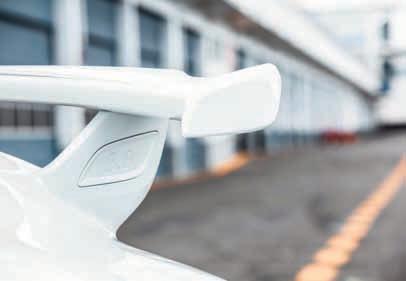
06_05_14 Body – Exterior equipment 6

7.1 General
The interior of the new 911 GT3 is based on the current 911 generation (991). It is enhanced by classic 911 GT3 features, such as Alcantara and completely newly developed components.
New interior equipment based on the current 911 generation (991):
• Elevated center console with new operating and design concept • New instrument panels and door panels • Sports seats Plus (new: with electric height adjustment) • Instrument cluster with 4.6-inch screen • 2-zone automatic climate control • New interior lighting (LED technology) • Universal audio interface (AUX) in glove compartment • New Porsche vehicle key
Differentiated features based on the classic 911 GT3 interior equipment:

• Equipment features in Alcantara (seat centers, steering wheel rim, selector lever handle, door handles, armrests on door panels, lid of center console storage box and rooflining. New: C-pillar trim panel and rear center tunnel trim panel) • “GT3” logos on the door entry guards and in the tachometer (New: embroidered into the headrests of the available seats and into the rear cover) • Instrument cluster with yellow pointers and increment markings (New: with new displays) • Tachometer with titanium colored instrument dial
New interior equipment including newly developed components:
• GT3 SportDesign steering wheel with shift paddles • GT3 selector lever and speed selection gate for PDK • PDK speed selection gate surround with “GT3” logo • Dashboard trim and center console trim in brushed aluminum • Rear cover with center tunnel trim panel in Alcantara • Optional Sport Chrono clock with matt black trim ring • Optional decorative stitching in Red (in conjunction with leather interior option) Body – Interior equipment 7
7.1 General 7.2 Steering wheel 7.3 PDK selector lever
Body – Interior equipment 7

With the new basic components of the current 911 generation (991), the new 911 GT3 models also feature a high-quality, attractive interior. In addition, the particularly sporty interior design has been upgraded further.
Particular highlights of the interior include the new elevated center console, the modified dashboard, the new door panels and omission of the handbrake lever. Other new features include the 4.6-inch color display at the right of the tachometer, the 7-inch color screen for the audio systems CDR, CDR Plus or PCM and the 2-zone air-conditioning system, which allows separate temperature adjustment on the driver’s and passenger’s side.
Interior equipment designed completely in black with elements in Alcantara is characteristic of the GT3 (991). On the new 911 GT3, these include the seat centers, the available seats, the steering wheel, the selector lever knob, the door handles, the armrests on the door panels, the lid of the center console storage box as well as the rear center tunnel trim panel and rooflining, including C-pillar.
In addition to various interior parts in Galvano Silver as on the current 911 generation (991), the new 911 GT3 features the dashboard trim and center console trim in brushed aluminum. In combination with the leather interior, the decorative trims on the door panels are also designed in brushed aluminum. Furthermore, the new 911 GT3 optionally features red decorative stitching with the leather interior.
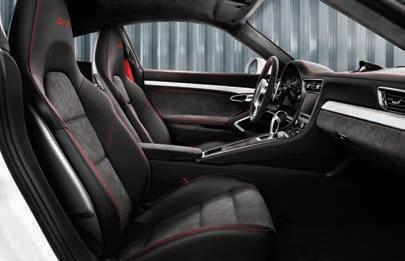
Interior (including leather option, decorative stitching in red and trims in Anthracite brushed aluminum. 07_01_14
Similar to the previous model, the new 911 GT3 features Sports seats Plus with higher side bolsters and mechanical fore-and-aft adjustment. Backrest adjustment and for the first time also height adjustment are controlled electrically. All seats available for the new 911 GT3 have a “GT3” logo in Platinum Gray embroidered in the headrests.

Sports seat 07_02_14 Adaptive sport seat Plus (option) 07_03_14
Sports bucket seat (option) 07_04_14 Body – Interior equipment 7
Body – Interior equipment 7

The rear cover, instead of the rear seat system used on the 911 Carrera models, is new. This was developed specifically for the new 911 GT3 and has a carpeted, level cover for the seat wells as well as a center tunnel trim panel finished in Alcantara. “GT3” logos in Platinum Gray are also embroidered at the left and right side of this trim panel.

07_05_14
7.2 Steering wheel
The new GT3 SportDesign steering wheel has a rim in black Alcantara and an airbag cover covered in black leather. Vertical adjustment and fore-and-aft adjustment, which has been extended by 10 mm, are still controlled manually. The shift paddles for manual gearshifts with the Porsche Doppelkupplung (PDK) have very short shift throws and allow extremely precise shifting on the new 911 GT3.
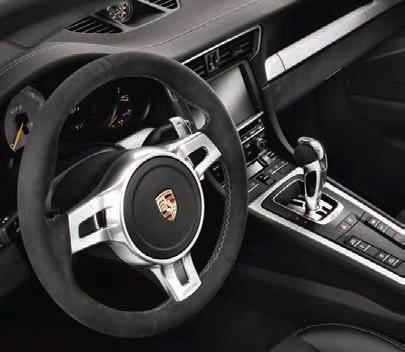
07_06_14
The PDK selector lever in the center console has a specific GT3 design. In keeping with the shape of a classic shift lever, the selector lever on the 911 GT3 has a round knob in Alcantara. The shift gate was also modified for the new 911 GT3 and has two central longitudinal stripes in black to highlight the particularly sporty setup of the Porsche Doppelkupplung (PDK).
The trim surround on the selector lever gate was also modified and does not have a shift pattern (P, R, N and D) on the right-hand side compared with the other 911 Carrera models with Porsche Doppelkupplung (PDK). On the 911 Carrera models, this is located next to the display in the instrument cluster and on the release lever for the selector lever knob on the new 911 GT3.
The shift-direction symbol “+” and “–” on the left-hand side of the selector lever gate was also changed. This is red on the new 911 GT3 and the arrangement of the symbols is based on motor sports. As a result, upshifts “+” take place backwards and downshifts “–” take place forwards on the new 911 GT3. The interior design is rounded off by inlays in the door entry guards featuring the “GT3” logo. Body – Interior equipment 7

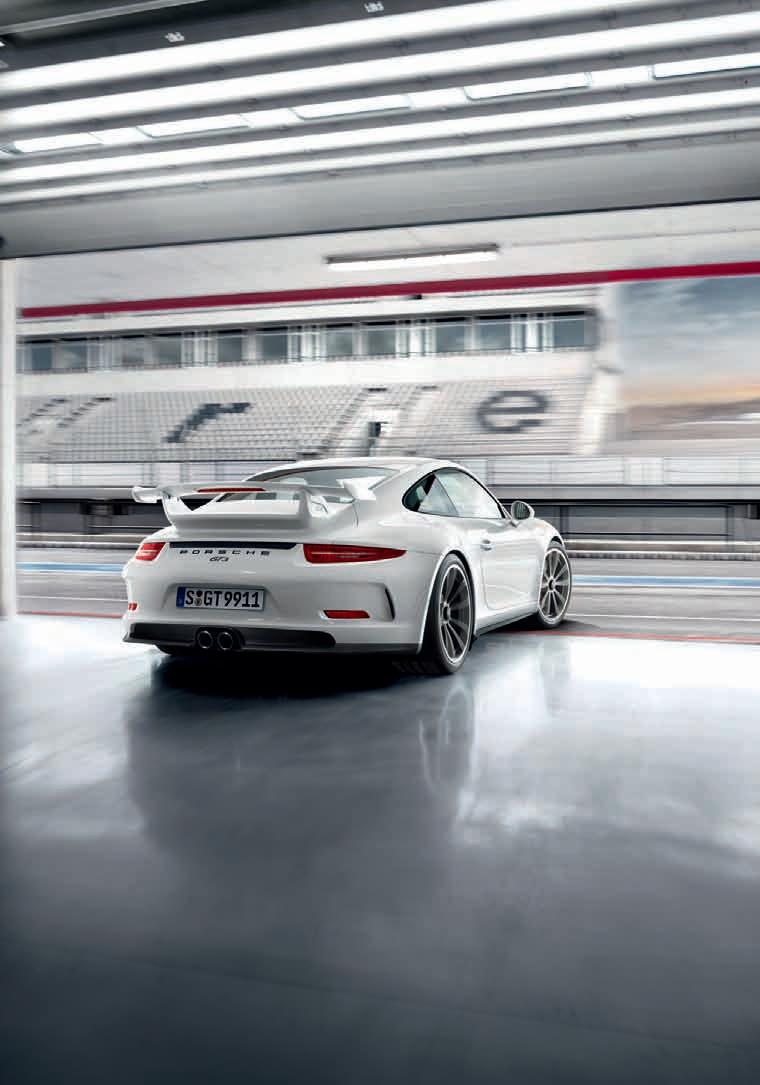
8.1 2-zone automatic climate control
Similar to the 911 Carrera (991) Sports Car, the 911 GT3 is now also available with 2-zone automatic climate control, which comes as standard equipment on the new 911 GT3. With this system, the passenger compartment temperature can be adjusted and controlled separately for the driver and passenger. The air distribution and air flow can be set and varied using the individual setting on the vents.
In order to also provide enhanced air-conditioning comfort for the 911 GT3, the “extended air-conditioning functions” that are available for the 911 Carrera (991) can now also be used in the 911 GT3. The functions listed below can be selected - in the usual way - via the on-board computer on the instrument cluster and in PCM (not in CDR).
The extended air-conditioning functions in the 911 GT3 include:
• Automatic air-recirculation mode (use of an air quality sensor) • Air flow adjustment (individual blower/air flow regulation) • Extended ventilation panel
All the functions of the air-conditioning system are largely identical to those of the 911 Carrera (991) and are described in the Service Information Technik (SIT) for the model year 2012 911 Carrera (991).

Center console with air conditioning control panel and air outlet vents 8_01_14 Heating and air conditioning 8

8.1 2-zone automatic climate control 83
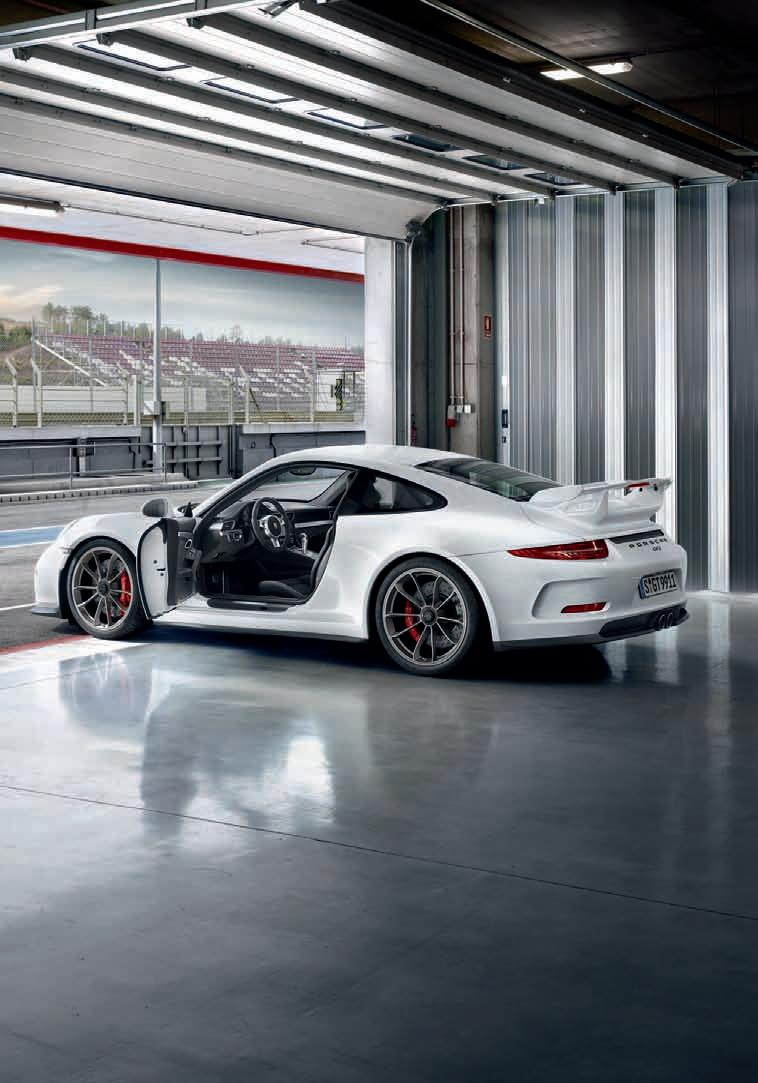
9.1 Vehicle electrical system/energy management
The vehicle electrical system used in the GT3 is based on that of the Carrera (991). The GT3 is equipped with a 95 Ah/520 A battery.
9.2 Lighting

Similar to the previous model, the new 911 GT3 features Bi-Xenon headlights with dynamic headlight levelling and a headlight cleaning system as standard. Their shape and design is the same as that of the current 911 Carrera models (911). The additional lights in the front apron are new compared with the previous model. These are also technically the same as on the new 911 Carrera models (991) and feature a narrow LED light strip as the daytime running lights. The turn signals and side markers are also designed using LED technology as standard equipment. To differentiate them from the 911 Carrera models, the inner trims on the front light modules are darkened on the new 911 GT3.
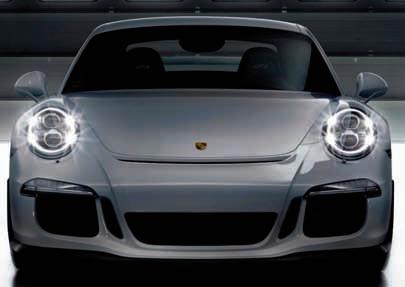
Front view of the 911 GT3 with LED headlights (optional) 09_02_14 Electrics and electronics 9
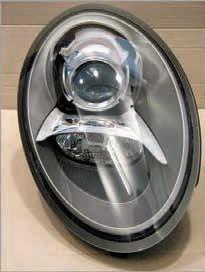
BiXenon headlights 09_01_14
9.1 Vehicle electrical system/ energy management 85 9.2 Lighting 85 9.3 Instrument cluster 90 9.4 Infotainment 90 9.5 Glossary 94
Electrics and electronics 9


LED headlights (optional) and LED front light modules (darkened) 09_03_14
An innovative full-LED headlight system is available as an option for the 911 GT3. The headlight system includes the following features:
• Headlights with dipped beam and high beam as well as additional high beam and 4point LED daytime running lights • Porsche Dynamic Light System (PDLS) with dynamic headlight levelling, speeddependent headlight range control, dynamic cornering light and headlight cleaning system. The central element of this system is the full-LED headlight. This essentially consists of the following 4 components: - Basic module - PDLS module - Auxiliary high beam - Daytime running light

LED headlights 09_04_14 4-point daytime running light 09_05_14
Similar to the differentiation between Bi-Xenon headlights, the term full-LED headlights describes the use of LED technology not just for dipped beam but also for high beam.
Topology
Electrics and electronics 9
Bi-Xenon headlights

If the GT3 is fitted with Bi-Xenon headlights, headlight control units with the required ballasts are installed on the headlights. Each ballast is integrated using a separate LIN (Local Interconnect Network).
LED headlights
The equipment variant LED headlights uses one central AFS (automatic driving light control) control unit, which uses a private CAN to activate two performance modules (LEIMO) for drum control (dynamic cornering light and variable light distribution).
09_06_14
Electrics and electronics 9


Headlight assembly 09_07_14
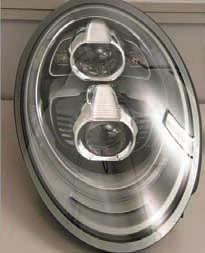
LED headlights 09_08_14

Location of AFS control unit. 09_09_14 • Visual differentiation using an attractive headlight design and a strong differentiation between the daytime running lights and night design • Driving safety thanks to fatigue-free driving using daylight-like LEDs - light color with higher perception of contrasts • Efficiency as a result of low energy consumption and LEDs that last much longer than Xenon lamps • Convenient light function with no switch-on delay
The basic module (1) in the upper part of the full-LED headlight is part of the dipped beam and ensures homogeneous and wide illumination of the road. Another part of the dipped beam is in the Porsche Dynamic Light System (PDLS) module located below the basic module.
With its pivot function and variable light distribution (rotating drum) this enables the PDLS functions:
• Dynamic cornering light • Highway light
The high beam is also contained in this module through an appropriate drum position for the projection headlight.
The additional high beam (3) in the upper part of the full-LED headlight consists of two sub-components and is located at the left and right of the basic module. Its high position and additional function ensure even better illumination of the road for greater driving safety, particularly when driving at high speeds. The daytime running lights (4) consist of four LED spotlights and a surrounding light ring.
Similar to the Bi-Xenon headlights, the full-LED headlights consist of a reflector/lens system for the basic functions. The light for the dipped and high beam functions is projected from the light source (LED) onto the road via a reflector and a lens or rotating drum (PDLS functions). The full-LED headlights have a very different look to the BiXenon headlights. Instead of a cone-shaped light housing with a round projection lens and auxiliary headlight with visible reflector, the full-LED headlight consists of two tube-shaped light housings in a stepped configuration. The dynamic design of the fullLED headlights is supported by an attractive color scheme for the individual headlight components.
The daytime running lights in the two headlight systems are also different. With the standard Bi-Xenon headlights, the daytime running lights are in the auxiliary lights on the front apron. With the optional full-LED headlights, the daytime running lights are integrated into the headlight housing as four LED spotlights surrounded by an LED light ring. The full-LED headlights therefore look different to the Bi-Xenon headlights with a total of four distinguishing features: Headlight design, daytime running lights, light color and night design.
The new tail lights are also designed completely in LED technology and their shape and function are the same as on the current 911 Carrera models. The additional reflectors in the rear apron have a distinctive shape. The high-level 3rd brake light, which is positioned centrally in the lower part of the rear wing, is also distinctive. The light with its red lens originates from the super Sports Car Carrera GT and has been integrated harmoniously and aerodynamically into the rear wing on the new 911 GT3.


09_10_14 Electrics and electronics 9
Electrics and electronics 9

The instrument cluster has been enhanced based on the current 911 generation and the familiar 911 GT3 specific appearance. The new 911 GT3 has an instrument cluster with a high-resolution color screen on the right of the tachometer. Similar to the previous models, the instrument cluster is differentiated by its black instrument dials with yellow needle and increment markings. The design of the tachometer instrument dial was also adopted from the previous models. The red rpm range, which only starts above 9,000 rpm, is a particular characteristic feature of the instrument cluster.
The Sport Chrono clock on the dashboard, which is available with the optional Sport Chrono package, adopts the design of the black instrument dials with yellow needle and instrument markings. Another distinguishing feature of the Sport Chrono clock is its matt black trim ring, which reduces the glare in the windshield.
The 4.6-inch, high-resolution color screen on the instrument cluster offers comprehensive display options. The information Vehicle, Audio, Trip, Tire pressure including Circular path (Racetrack function), as well as the options Navigation, Map, Phone and Chrono can also be displayed here. The new 911 GT3 features the G-forces display as standard (available with the optional Sport Chrono package on the 911 Carrera).
The 911 GT3 (991) also features a performance display for power and torque as standard. This shows the load point for the current driving situation in the form of a dot display (trackball) in the power and torque map based on the engine speed and throttle position.
9.4 Infotainment
General
State-of-the-art audio and communication systems based on the current Boxster and 911 generation are used on the new 911 GT3. The new 7-inch color screen of the standard CDR audio system or the optional CDR Plus system and of Porsche Communication Management (PCM) is positioned higher up and is designed as a touchscreen for fast and easy operation.
CDR audio system
The new, standard CDR audio system has an extremely high-quality user interface. The look, feel and central functions correspond to the also new PCM generation. The main feature of the new audio system generation is a 7-inch display with touchscreen. All the functions (except for volume) of the CDR system can thus be controlled by touching the color screen. This allows fast and simple navigation through the various menus.
The standard audio system also features 4 speakers, a total output power of 2 x 25 W and can be used to play audio CDs and music in MP3 format (formats: mp3, aac, wma). A 6-disc CD autochanger integrated in the CDR system is available instead of the standard single CD drive. The standard universal audio interface makes it possible to connect an external audio source via the AUX interface.
The system is then controlled directly on the connected device. The AUX interface is in the glove box. There is a 12 V plug socket in the glove box for supplying power to the external audio source. A digital satellite radio Satellite Digital Audio Radio Services (SDARS) from the provider XM is also available in combination with the CDR audio system in the USA and Canada.


CDR audio system 09_11_14
Sound Package Plus
The new 911 GT3 offers a superior sound experience with the optional Sound Package Plus. With 9 loudspeakers divided into 7 channels as well as an external amplifier, a total output of 235 W is available. Electrics and electronics 9
Electrics and electronics 9

The new “CDR Plus audio system” option (P25) with Sound Package Plus is based on the same technology as Porsche Communication Management (PCM) without the navigation module and includes the following features:
• Convenient light function with no switch-on delay • 9 loudspeakers with a total output of 235 watts • High-resolution 7-inch touchscreen • Radio with analogue and digital double tuner for receiving radio stations in the
FM/AM bands as well as in the formats DAB, DAB+ and DMB • Single CD/DVD drive including audio playback of music in MP3 format and audio/video DVDs • USB connection for various iPod and iPhone models, USB memory sticks with MP3 music and MP3 players • Option for displaying cover art and playing podcasts and audio books. It is controlled via the CDR Plus audio system • AUX interface for connection of other external audio sources which are then controlled directly via the connected device
With the CDR Plus audio system, the customer gets an attractive equipment package. An impressive digital music experience is guaranteed, especially for customers who have no need for the navigation function, by the USB connection and the digital double tuner together with the improved sound output of 235 W from 9 loudspeakers. Other useful options, e.g. the telephone module or the 6-disc DVD autochanger, can also be combined with the CDR Plus audio system.
The latest generation of Porsche Communication Management (PCM) including navigation module is optionally available for the 911 GT3 (991). The main features of the latest generation of PCM in comparison with the previous version are:
• High-resolution 7-inch touchscreen • 3D navigation map with City and Terrain models with superimposed satellite map • Speed limit display in PCM based on navigation data • Map display in the instrument cluster
Audio transmission via Bluetooth® is available with the new PCM generation. This allows audio data to be transferred from external devices such as music players or mobile phones via the Bluetooth® interface of PCM or reception of internet radio if this function is supported by the device connected via Bluetooth®. The universal audio interface assigned to PCM has also been modified: various iPod® and iPhone® models can now be connected to the audio system via the USB connection.
The GT3 also includes the mobile phone preparation, telephone module, voice control, CD autochanger and CD/DVD autochanger options.
Sport Chrono package
A Sport Chrono package is also available as an option for the new 911 GT3. It includes an analog stopwatch on the dashboard and a digital stopwatch in the instrument cluster. In combination with the optional Porsche Communication Management (PCM) system, the Sport Chrono Package features an additional performance display in PCM, as on the previous model. Electrics and electronics 9

Electrics and electronics 9









